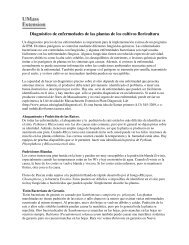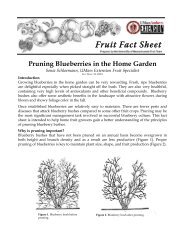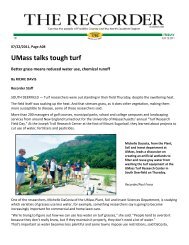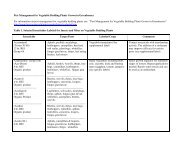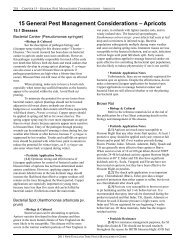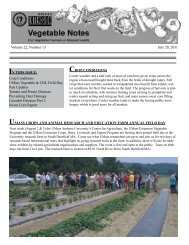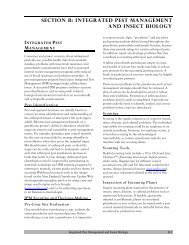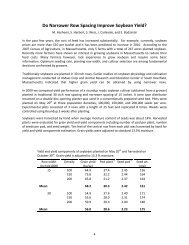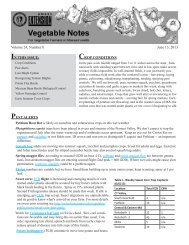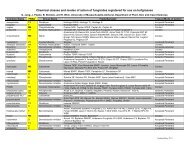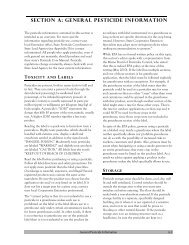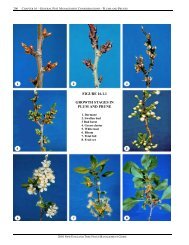Selecting an Energy/Shade Screen System - UMass Extension
Selecting an Energy/Shade Screen System - UMass Extension
Selecting an Energy/Shade Screen System - UMass Extension
Create successful ePaper yourself
Turn your PDF publications into a flip-book with our unique Google optimized e-Paper software.
Fact Sheets<strong>Energy</strong><strong>Selecting</strong> <strong>an</strong> <strong>Energy</strong>/<strong>Shade</strong> <strong>Screen</strong> <strong>System</strong>John W. Bartok, Jr., Agricultural Engineer - EmeritusNatural Resource Mgt. & Engr. Dept.University of ConnecticutStorrs, CT<strong>Energy</strong>/shade screens are one of the most popular methods of reducing greenhouse fuel usage. Savings of30-50% in heating costs are common in m<strong>an</strong>y installations. Often referred to as energy bl<strong>an</strong>kets orcurtains, screens save energy by reducing the heat loss surface area, providing <strong>an</strong> extra insulation barrier<strong>an</strong>d trapping <strong>an</strong> insulating layer of air on both sides of the screen material. If the material contains somealuminum, the infrared part of the heat within the greenhouse will be reflected back toward the pl<strong>an</strong>tsreducing heat loss <strong>an</strong>other few percent. The aluminum strips c<strong>an</strong> also save energy in the summer byreflecting the incoming heat back out of the greenhouse.With a typical cost of $2.00-2.50/sq ft installed, the payback usually works out to 1-3 years. This c<strong>an</strong> beinfluenced by the fuel cost, length of the heating season, climate <strong>an</strong>d the night greenhouse temperature.Select the best systemAlthough energy screens c<strong>an</strong> be installed in free-st<strong>an</strong>ding greenhouses <strong>an</strong>d hoophouses, they are mostcommon in gutter-connected r<strong>an</strong>ges. The st<strong>an</strong>dard system uses nylon monofiliment or stainless steelcables to support the bl<strong>an</strong>ket material. The material c<strong>an</strong> either rest on top of a network of cables or besuspended by hooks from the cables. A gearmotor powers a drum or rack <strong>an</strong>d pinion that moves theleading edge of the bl<strong>an</strong>ket material.<strong>Energy</strong>/shade screens c<strong>an</strong> be installed gutter to gutter or truss to truss. Factors to consider with the gutterto gutter system are:•Less volume of greenhouse has to be heated.•Less material is needed but it forms a larger bundle in the storage position.•Installation is easier as work is done at a lower height.•Equipment c<strong>an</strong>not be supported from the lower truss cord.Truss to truss systems are generally more common. They c<strong>an</strong> be installed flat at the gutter or up near theroof glazing (6-12" spacing). Configurations of slope-slope or slope-flat-slope are used.These systems:•Usually require more material.•More space has to be heated.•Heating, lighting <strong>an</strong>d watering equipment may not have to be moved.In m<strong>an</strong>y gutter connected greenhouses a lightweight truss c<strong>an</strong> be installed below the screen (energy truss)to support heating, HAF, water, electrical systems <strong>an</strong>d h<strong>an</strong>ging baskets. Adequate gutter height is neededas this truss usually takes up about two feet of space. It is import<strong>an</strong>t when building a new greenhouse to<strong>an</strong>ticipate the installation of the screen by keeping the truss area free of electrical, plumbing <strong>an</strong>d otherobstructions.
Some growers in northern climates are installing two screen systems. The lower screen has a high energyrating <strong>an</strong>d the upper one is mainly for shade but provides additional energy savings when extended atnight. This may provide <strong>an</strong> additional 10 to 15% savings in fuel. Sidewall screens are also becomingpopular especially with the taller gutter-connected houses. These usually roll-up under the gutter or at thewall purlins.<strong>Screen</strong> drive systemsThree types of drive systems are used to move the screen, cable <strong>an</strong>d drum, push pull <strong>an</strong>d chain <strong>an</strong>d cable.The cable <strong>an</strong>d drum system operates like a clothesline. It uses a gear motor that rotates a shaft near thecenter of the greenhouse. A stainless steel cable wrapped around a grooved drum connects shafts at eachbay. The cable is attached to the leading edge of the screen. It extends the screen when the cable pulls theleading edge. It gathers <strong>an</strong>d retracts the screen when moved in the other direction. Depending on thelayout of the greenhouse, one drive motor c<strong>an</strong> h<strong>an</strong>dle up to 40,000 sq ft of screen material.Push <strong>an</strong>d pull systems are used for truss to truss systems. Pinion gears on cross shafts move the toothedracks back <strong>an</strong>d forth over the dist<strong>an</strong>ce between the trusses. The leading edge of the curtain in each spacebetween the trusses is connected to the racks <strong>an</strong>d provides back <strong>an</strong>d forth motion.The chain <strong>an</strong>d cable drive system is similar to the push <strong>an</strong>d pull system with the exception that lengths ofroller drive chain moved by a gearmotor <strong>an</strong>d sprockets pulls or pushes the leading edge of the curtainbetween the trusses or across the width of the greenhouse.There are screen systems available that c<strong>an</strong> be installed in hoophouses. These are usually more difficult toinstall due to the shape of the structure <strong>an</strong>d the amount of overhead space available. They also eliminatethe space for h<strong>an</strong>ging baskets.I have seen a simple system installed in a hoophouse that uses a light weight steel cable stretchedhorizontally at each bow at 8-9' above the floor. The cable is attached to the bow with b<strong>an</strong>d clamps. Thescreen material is attached to the hoops at one side <strong>an</strong>d rolled on a piece of tubing across to the other sideforming <strong>an</strong> insulating ceiling. The inflated poly usually creates a seal at the sidewall. The ends of thescreen roll over a fixed section of poly attached at the endwall <strong>an</strong>d first cable to create a seal. Cost of thissystem is less th<strong>an</strong> $1.00/sq.ft. for the materials.Select the right screen materialAlthough the same mech<strong>an</strong>ical support system c<strong>an</strong> be used for energy savings, shading or photoperiodcontrol, the screen material is different. The most common materials for energy screen are compositefabrics of alternating strips of clear <strong>an</strong>d aluminized polyester or acrylic held together by a finely wovenmesh of threads. Other materials available include knitted <strong>an</strong>d woven bonded polyester, metalized HDPE(high density polyethylene) <strong>an</strong>d polyproplyene. Things to look for when selecting a material include thewarr<strong>an</strong>ty life (usually 5-10 years), strength <strong>an</strong>d flexibility.M<strong>an</strong>y screen materials are designed to also provide shading during the summer. For comparison ofmaterials, m<strong>an</strong>ufacturers list both the shade factor <strong>an</strong>d the energy savings. <strong>Shade</strong> percentages from 10-100% <strong>an</strong>d energy savings percentages from 20-75% are available. When selecting a shade screenmaterial, consider the crop to be grown <strong>an</strong>d the time of year. For most crops a shade material thatprovides 30-50% reduction is satisfactory. Too much shade limits the amount of light that reaches thelower leaves in the c<strong>an</strong>opy<strong>Screen</strong>s c<strong>an</strong> also have <strong>an</strong> open or closed weave. The closed weave has a higher energy savings <strong>an</strong>d is usedin greenhouses with f<strong>an</strong> ventilation systems. For natural ventilation, <strong>an</strong> open weave allows the heat to risethrough the screen when it is extended. Some growers install a closed weave <strong>an</strong>d then crack the screenopen to allow the heat to escape · up through the roof vents. Some porosity is desirable to prevent
accumulation of moisture on top of the screen <strong>an</strong>d the thread used to sew the strips together usuallyprovides this.<strong>Screen</strong>s c<strong>an</strong> also be used for photoperiod (daylength) control. Polyester or composite materials with <strong>an</strong>aluminized top layer <strong>an</strong>d opaque bottom layer are popular as they reflect the incoming radiation to reducethe temperature buildup. They also allow water <strong>an</strong>d moisture to pass through. These materials have a99.9% light exclusion. Sidewalls have to have a similar system to maintain darkness.Fire safetyMost screen materials are plastic. In a fire these c<strong>an</strong> support combustion <strong>an</strong>d increase the intensity of thefire. <strong>Screen</strong>s have been the cause of the spread of several greenhouse fires. Materials selected should beeither have a fire break installed or be fire-retard<strong>an</strong>t. The fire break is usually section of fire-retard<strong>an</strong>tmaterial on both edges of a screen p<strong>an</strong>el. It reduces the flame travel. In controlled tests (LudvigSvensson), fire break material reduced the peak heat released by more th<strong>an</strong> 20 times over plainaluminum/polyethylene screen material. The fire-retard<strong>an</strong>t material, although more expensive, reducedpeak heat release more th<strong>an</strong> 200 times.In general, a fire break material is the minimum requirement for production greenhouses. A fire retard<strong>an</strong>tmaterial should be used for retail greenhouses open to the public. The closure strip installed along thesidewalls of the greenhouse should be fire-retard<strong>an</strong>t material to prevent the spread of the fire from p<strong>an</strong>elto p<strong>an</strong>el.Experience has also shown that the polyester monofilament wires c<strong>an</strong> cause spread of a fire. Use eitherstainless steel or the new fire-retard<strong>an</strong>t polyester wire (FT Wire) for the support cables.Installation <strong>an</strong>d mainten<strong>an</strong>ce are keys to energy savingsA screen system is easiest to install if the greenhouse is empty of pl<strong>an</strong>ts. The long cables <strong>an</strong>d large piecesof screen require open space during installation. M<strong>an</strong>-lifts are frequently used to elevate workers to thetruss level <strong>an</strong>d require space to m<strong>an</strong>euver.Closed weave energy screens need to be installed to provide a tight seal all the way around the edges.There are several ways to get a good seal. In most screen installations, one edge is perm<strong>an</strong>ently attachedto a truss or gutter. The leading edge usually has a sealing flap. The side edges ride along a ledge ofpolycarbonate sheets or fire-resist<strong>an</strong>t screen material.Typical temperatures that would be observed in a heated greenhouse on a cold night might be 60°F underthe screen <strong>an</strong>d 35-40°F above. I have been in greenhouses where it was warmer above the screen th<strong>an</strong>below showing that heat was escaping through holes, gaps or around the edges of the screen. Rememberthat heat supply pipes that are above the screen have to be insulated or moved lower.Regular mainten<strong>an</strong>ce is needed to keep proper tension in the cable system. Pulleys <strong>an</strong>d gear motorsshould be lubricated once or twice a year. <strong>Screen</strong> materials tend to wear on rub points <strong>an</strong>d where they aresupported by hooks. Repairs may have to be made at these points.Control the screen by outdoor light levelIt is import<strong>an</strong>t to properly use <strong>an</strong> energy/shade screen. It has to be closed <strong>an</strong>d opened at the right timebased on weather conditions <strong>an</strong>d the time of year. Operation c<strong>an</strong> be done m<strong>an</strong>ually or automatically usinga photocell or time clock. Light activated operation is most desirable <strong>an</strong>d doesn't have to be ch<strong>an</strong>ged withthe seasons. A light level of 50 ftc is a good threshold point. Most environment controllers <strong>an</strong>d computersc<strong>an</strong> be programmed to operate a bl<strong>an</strong>ket system.
OperationIf a screen is opened rapidly, the cold air from the attic will flow down to the pl<strong>an</strong>ts. Some pl<strong>an</strong>ts aresusceptible to damage from this cold air. Setting the controls to open the screen slowly over a half houreliminates this problem. Some growers solve the problem by waiting for the sun to warm the attic beforethe screen is opened.To prevent damage to the greenhouse structure, energy screens should remain open when snow ispredicted. The heating system should be designed for the heat loss with the screen retracted.The installation of <strong>an</strong> energy/shade screen becomes more attractive as fuels prices continue to rise. Thekey to a good installation is the use of good materials <strong>an</strong>d having tight seals around the edges.10/09 Floral Notes Newsletter



